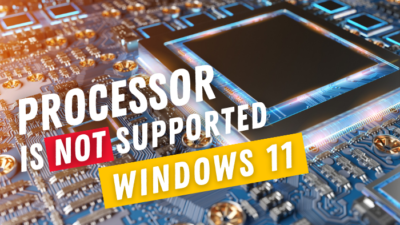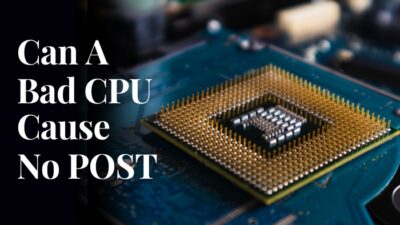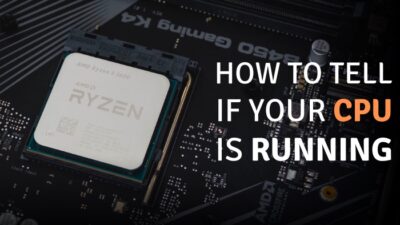Are you seeking a decent CPU that can deliver close to top-tier performance? But trying to decide which one to pick, a 4-core or 6-core CPU!
Well, if you take a look at the number, it speaks for itself. But if you compare this CPU side by side, you’ll know for sure.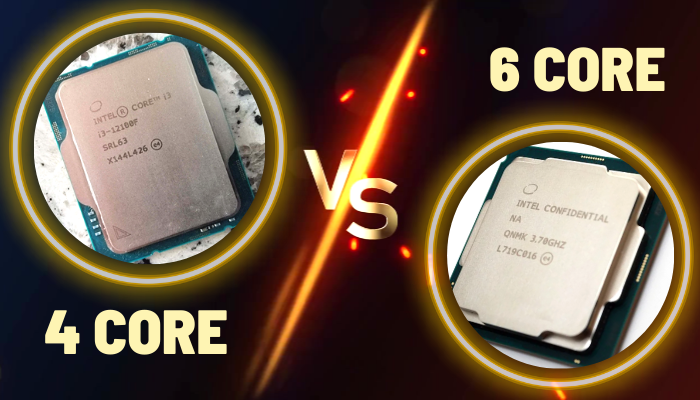
Let me help you by showing you the perfect comparison of four-core vs. six-core. After reading this article, you’ll know which one to pick. So, let’s begin!
How CPU Cores Work
A CPU core is a single independent processing unit that gathers instructions and executes them simultaneously. So, when a core executes an instruction, at that time, another core starts executing from the queue. That’s why multicore processors are faster and more efficient.
But that doesn’t mean more cores will win you a badge of honor because not all the cores work at once if not needed. Let me explain you in a simplified way.
Assume a table drawer has six chambers in it to put things separately. But, some chambers will remain empty and idle if you don’t have enough items. Similarly, a six-core CPU won’t use all the cores unless it finds enough instructions to assign to all the cores.
So, more workloads can use the full potential of a multicore processor. Assume ticket counters as cores and people as instructions. It’ll be more chaos if a train station has only two ticket counters than four or six. People will stand in a long line to get their tickets at those two ticket booths.
But with four or six booths, people will split up, and they can buy tickets faster. Similarly, a CPU can’t execute many instructions once if it has only two or four cores. The remaining tasks wait in the queue.
If your inner geek needs more explanation about what a CPU is and how is works, check our separate article where we go in-depth.
Differences Between 4 Core Vs. 6 Core
The number alone 4 & 6 cast out the main difference between these 4-cores & 6-cores. Plus, performance is also noticeable between them. You’ll also find a significant heat bump in the Hexa core-based CPUs. But remember, a CPU with weak Hexa cores can’t surpass a powerful Quad-core.
Let me show you all the main differences by categories all the differentiations.
Here are the major differences between 4-cores and 6-cores:
Cores
The physical core count is a significant fact in delivering high performance. Honestly speaking, a quad-core can’t handle the workload as fast as a Hexa core will. Not all the cores will work at a time because the first two or three cores of the 6-core CPU might finish the execution.
So, you should keep the six-core at the top of the priority list if you need to handle CPU-intensive workloads. The sad but true fact is a weak six-core CPU can’t compete against a powerful four-core CPU. Before buying one, read the detailed spec sheet.
We have a separate article that details how to check the number of CPU cores on your computer. Do check it out.
Processing Speed
A CPUs processing speed is a key factor, measured in GHz. GHz resembles a clock that beats a set number of times per second. A CPU marked with 3.8 GHz means its clock speed is 3.8 billion per second.
The number of cycles a CPU executes per second is the clock speed of that specific CPU. Hexa core-based processors have a higher number of GHz, but not for all. It depends on the series of the particular CPU.
Six core CPU naturally has a faster processing speed than a four core.
If a six-core CPU has a lower clock speed than a four-core, it will execute all the instructions faster with more cores.
So, GHz does matter to deliver high performance, and if you want to explore this fact a bit more, you can dive deep.
Base Vs. Boost Clock
Base clock speed is the frequency at which a CPU handles all the low-level tasks, such as browsing the net, working in Word or Excel, light image editing, etc. Even when the CPU is idle, you’ll find it’s holding the base clock speed from time to time. But the clock speed fluctuates randomly.
Modern CPUs can keep the CPU under the base clock to save power. When you launch any app, it will start working with the base clock. Boost clock speed pushes when a CPU executes heavy work with maximum power.
Six-core based CPU finishes tasks faster with its boosted clock speed whether it has a lower base clock than a four-core CPU. When six cores working in the boosted frequency can execute heavy workloads faster than four cores will.
Well, you can research a bit more to know about all the significant factors of base vs. boost clock speed.
Multithread
If you have two more extra sub-hands, you can work more, right? Similarly, multithreaded CPUs can handle more tasks with the help of extra virtual cores along with physical cores. Four cores with eight threads can handle all the tasks with ease.
But can it exceed a Hexa core?
Without any doubt, it can’t compete against 6-core & 12-threads or 6-cores with 6-threads CPU. Because not all the apps use the multi-threads, the two extra cores will cover up the multithreading lackings.
But there are some exceptions; from the benchmark, I found that core i5-4690K (4-cores) is better than FX 6300 (6-cores). So, having more cores doesn’t mean you can win with it. The same goes for a CPU with hyperthreading and another one with non-hyperthreading.
The below chart shows i5-4690K vs FX-6300 performance differences:
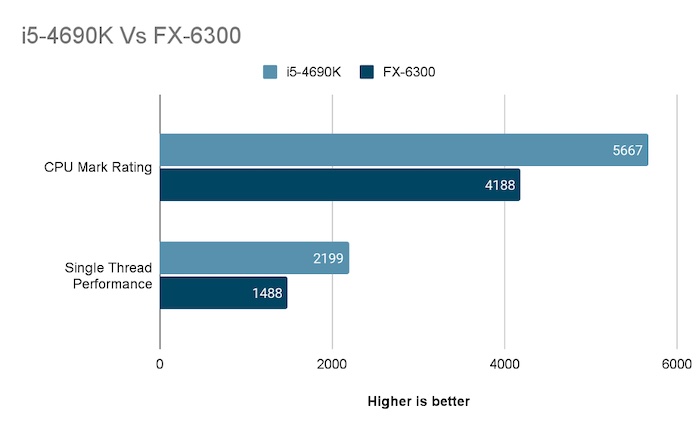
The i5-4690K has a lower TDP of 88W, and FX-6300 has a TDP of 95W. Despite having a lower TDP, the four-core i5 outruns FX-6300.
Hyperthreading facilitates the CPU for sure, but physical cores are facts.
Heat Generation
More cores will produce more heat, and it’s natural. When the CPU executes all the instructions, it hits the boosted clock speed, producing heat. More clock speed means more heat.
When all six core work simultaneously, it will generate more temperature than four cores. So, heat generation is higher in hexa core CPUs.
Heat can cause overheating and that results in a lag in games. We have explored how heat affects your gaming sessions in a separate article. Do check it out.
IPC
IPC stands for Instructions per cycle, representing the number of instructions a CPU can complete in one cycle. The higher IPC indicates a powerful CPU. But a multicore CPU with a lower IPC is not a good option to buy.
You won’t find IPC in the CPUs spec sheet, but you’ll notice it in the benchmark. Modern CPUs come with higher IPC, and that’s why four-core-based CPUs have less IPC than a six-core CPU.
We have explored a CPU’s IPC in great depth in a separate article. Do check it out
iGPU
iGPU or integrated graphics comes with the CPU and can perform sufficiently for typical daily tasks. Integrated graphics vary from gen to gen. If you compare similar gen’s four-core CPU with a six-core one, you’ll get the same level of integrated GPU.
But the latest gen six-core processor will have a better iGPU than its previous gen’s four or six-core processor. You can find if your CPU comes with iGPU in another article.
I hope you get all the key differences between 4-core and 6-core CPUs. Some cores might not work when the CPU is idle because they are in the perked state. But you can enable all the cores of a CPU if you want to remain active all the time.
Quad Core Vs. 6 Core: Which is Better?
To know which CPU is better, a quad-core or a hexa-core, you must know how these CPUs perform in gaming, office work, or graphical-related work. If you are using the PC only for moderate usage, you can select a four-core CPU, but a hexa-core CPU is a must for high workloads.
Here are the key factors in determining the better CPU between a quad-core and a hexa-core:
Gaming
When you’re gaming, you’ll see a significant performance boost when you shift from a four-core to a six-core CPU. While gaming, all the CPU cores execute tons of data. Gaming with higher resolutions needs a powerful processor.
Some might think GPU is the main factor for gaming, but it’s a misconception. You must need a high core-based CPU and a high-end GPU that can handle graphical and logical calculations as quickly as possible.
Games like Total War: Warhammer 2 will run without issues if you have a six-core CPU rather than a four-core. But older games are playable with lesser-core CPUs.
I have tested i5-9400F by playing the Dalaran Stree race. I configured the CPU with two-core, four-core & six-core for testing purposes and found the below result while gaming.
The following chart shows the gaming performance comparison for the different core counts of the same processor:
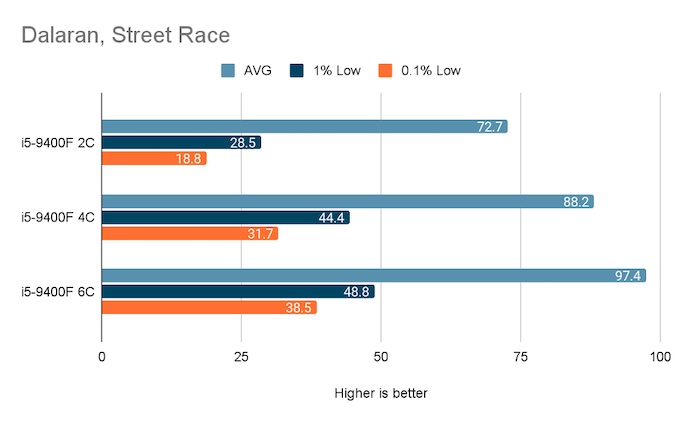
So, for gaming, a six-core CPU is a game changer.
Office Work
If you want to choose a CPU between a six or four-core, you should select the six-core one because it will help handle all the office-related apps easily. More core means more applications can run simultaneously without compromising performance.
You can switch between apps without any stutter or issues. Essential apps like MS Word, Excel, Outlook, and Spotify will only use a single thread. For these apps, you can go for a four-core CPU.
But if you want to run heavy apps like programming-based software, you must shift to a six-core CPU. Moving to the six-core CPU for future proofing will open apps faster without issues.
Graphics-based Work
There is no alternative to using a higher core-based CPU when editing images, designing graphics, rendering videos, or editing videos. More cores are a must to handle all the CPU-intensive work because all the video editing apps need to execute more instructions at a time.
Image editing requires applying multiple layers and effects or exporting that image to a high resolution. So, you need more cores with high clock speeds for all these. Rendering videos is a high CPU-intensive work.
A processor with a six-core can render videos faster than a four-core CPU. 3D modeling is a complex task, and it needs lots of processing power of both CPU & GPU. When you use CAD software, you must prefer a six-core CPU over a four-core. However, you can upgrade CPU without even reinstalling Windows if both the 4 & 6 core CPUs are from the same family, such as Zen 2.
So, a six-core CPU is a suitable spot for graphics-based work.
It’s not just the gamers who need a GPU. You also need a good GPU to handle your productivity work. Read our separate article where we’ve covered this topic in great detail.
Day-to-Day Use
For day-to-day or moderate usage, you can count on a 4-core CPU. Browsing the internet or watching movies don’t require more than 4-cores, and it’s enough for these types of tasks.
So, I think you should choose a 4-core processor for daily usage with light apps.
I hope you get a clearer picture of which CPU to use, four-core or six-core. If you want my expert opinion, I suggest going for the higher core count CPUs. It will ensure future-proofing for both gaming and graphics-related works and so on.
FAQs
Are 6-core CPUs better than 4-core?
For daily usage like browsing the web, watching videos, and normal image editing, you can count on 4-cores. But gaming, video rendering, and 3D modeling must need a 6-core CPU.
Is a 4-core CPU enough for daily usage?
For moderate daily usage like light gaming, web browsing, and working with Word or Excel, you can count on a 4-core CPU.
Do you need a 4 or 6 cores CPU?
If you play AAA-titled games a lot, edit videos, or render them all the time, you just need a CPU with six cores. Other than moderate daily usage, you can count on a four-core CPU.
Conclusion
Modern apps and games run great with powerful processors because those are programmed to use all the cores. For ensuring high performance, more cores are a blessing.
That’s why games, video rendering, or 3D modeling requires powerful CPUs with more cores. I have shown all the key differences between a 4-core and a 6-core CPU in this article. The comparison shows that a 6-core CPU is better in every aspect.
For more CPU-related queries, knock me in the comment box. See you at the next one. Good luck!

